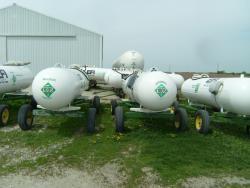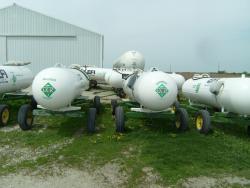In 1932, J. O. Smith, Agricultural Engineer at Delta Branch Experiment Station in Stoneville, MS, attached a small anhydrous ammonia cylinder to a plow in such a manner that the NH3 was released in the soil. The plow, a Georgia Stock, was pulled by a gray mule named Ike. This was the first known use of anhydrous ammonia as a soil-applied crop fertilizer. The crude apparatus and the anhydrous ammonia it applied provided a much needed source of nitrogen for the otherwise rich alluvial soils of the Mississippi Delta.
38776

YearAdded:
Image Credit: Courtesy Flickr/thirteenofclubs (CC BY-SA 2.0)Image Caption: Anhydrous Ammonia is one of the cheapest forms of nitrogen fertilizer available on the market. However because it is such a hazardous material and is difficult to apply, many farmers choose to hire third party businesses to store and apply the fertilizer.
2011
Innovations

In 1932, J. O. Smith, Agricultural Engineer at Delta Branch Experiment Station in Stoneville, MS, attached a small anhydrous ammonia cylinder to a plow in such a manner that the NH3 was released in the soil. The plow, a Georgia Stock, was pulled by a gray mule named Ike. This was the…
Read More

